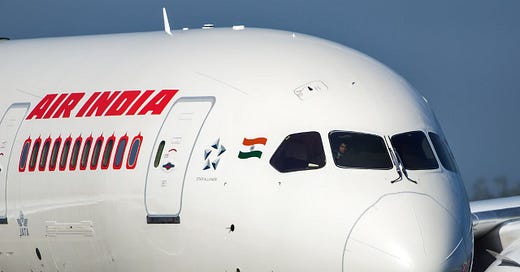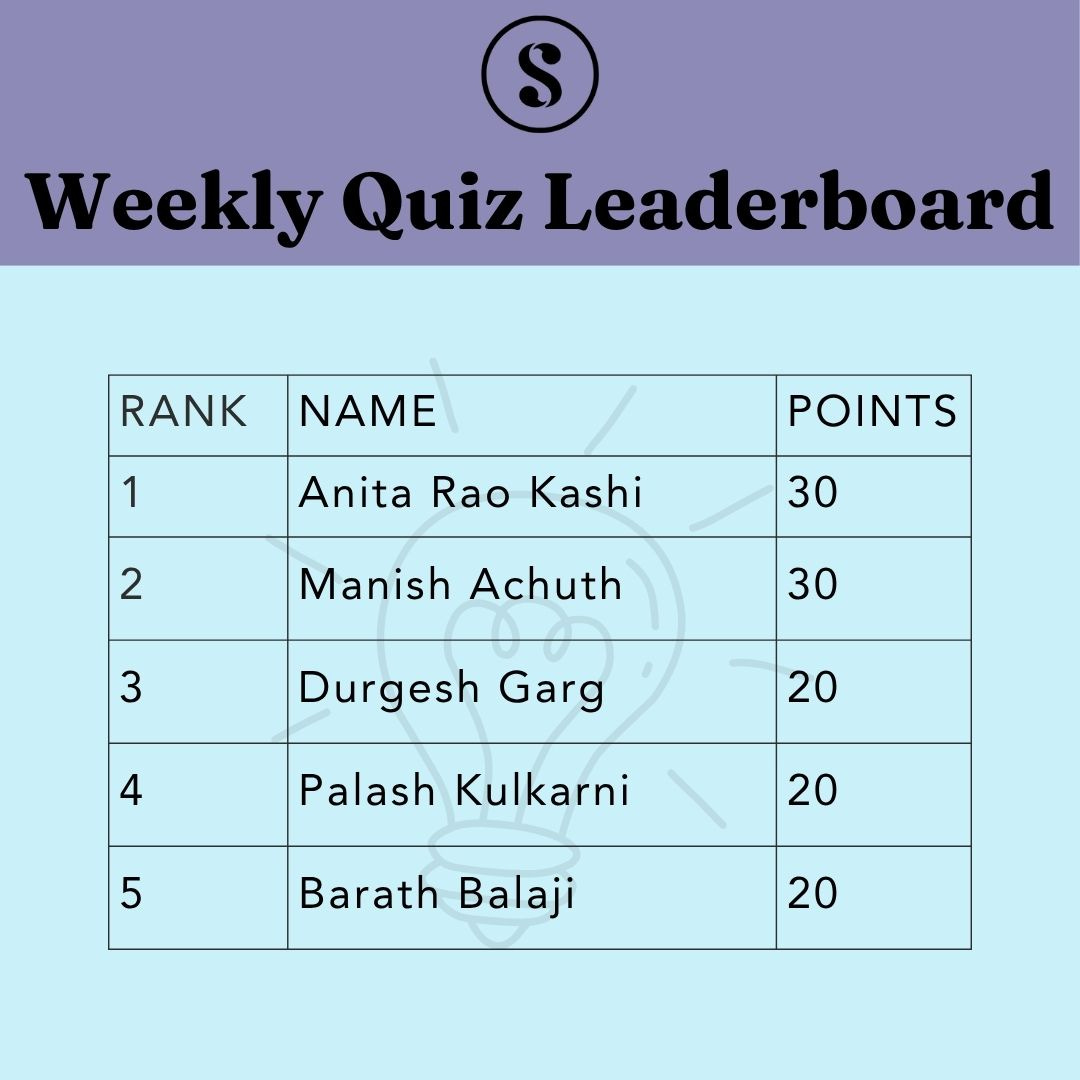Splainer FREE: We Hear a RAT
Aaj ki khabar includes an update on the Air India crash, a military parade for Donald’s birthday bash & a plastic that dissolves in salty water. Our fave bit: South Africa are World Test Champions!
Hello, splainer FREE subscribers! We launched a paid version of our daily headlines in January. Our splainer LITE subscribers will get: One: Extended headlines every day (For example: deets on what went wrong in the Air India Dreamliner plane crash, today). Two: A deep dive on a big story each month—so be sure to read our Big Story on the Architecture biennale underway in Venice. Three: A fab pop culture explainer that keeps you clued-in and nerdy cool (For example: this explainer on the misunderstood sexual orientation: Asexuality). All this for Rs 99 per month only! Be sure to sign up here—and gift the sub to friends & fam.
Bibi bombs Iran: Master stroke or armageddon?
The TLDR: On Friday, Bibi Netanyahu found his next war. In this week’s Big Story we look at why Israel bombed Iran. The reason: Tel Aviv bombed Iran’s nuclear facilities, claiming it was close to developing nine bombs. No, we don’t know how this story goes. This is Tehran not Gaza.
Written by: Aarthi Ramnath, Raghav Bikhchandani & Yash Budhwar
The Air India crash: What we know now
Quick reminder: On Thursday, Air India flight 171—headed from Ahmedabad to London’s Gatwick airport—crashed moments after takeoff into a dining hall of a medical college hostel. The death toll: 279—38 were killed on the ground. There were 242 people onboard, and by sheer miracle, one survived—40-year-old British national Vishwash Kumar Ramesh, who was seated in 11A.
We have new clues: We now have far clearer footage of the crash—filmed by local student and photographer Aryan Ansari. Experts say the audio and imagery offer fresh clues about the possible cause of the crash:
In the grainy 18-second video, the aircraft flies low over rooftops, steadily losing altitude before crashing with a burst of flames and smoke. Pilots say the footage also appears to show a Ram Air Turbine (RAT) deployed from beneath the fuselage and a subtle shift in sound consistent with the RAT.
Experts say it “sounds like a propeller plane going by. A high-pitched squeal.”
Wtf is a RAT?: It is essentially “a two-bladed propeller” that automatically deploys to provide electrical and hydraulic power to an aircraft in an emergency. What this could indicate: a twin engine failure, which is considered a ‘rarest of rare event’. The hypothesis is bolstered by the absence of the normal roar of jet engines.
Fatal lack of altitude: According to Indian aviation experts, pilots are trained to fly and land aircraft with dual-engine failures—but at heights between 5,000 and 30,000 feet. This plane barely reached 600 feet—which makes it impossible to take corrective action:
The engines typically take up to 90 seconds to relight — there has to be time for this. We know that a complete loss of thrust at 600 feet gives pilots no time to recover. We don’t simulate such scenarios. We don’t want to demoralise trainees.
But, but, but: This new theory raises a new question: Why did both engines fail? We don’t have any answers as yet.
The black box says: Investigators have recovered two black boxes at the crash site—the Cockpit Voice Recorder and Flight Data Recorder. We now know that the aircraft “started sinking” within seconds after takeoff—and the pilot Captain Sabharwal issued a “Mayday” call to the air traffic controller, declaring a full emergency. He said “thrust not achieved" and “falling.”
The Boeing angle: Given its catastrophic safety record in recent years, the media has focused on issues with the Dreamliner. Air India owns 36 of them. American Prospect spoke to some of the whistleblowers:
[Two] people deeply familiar with the Charleston 787 plant told the Prospect they had particularly acute quality concerns over planes that were delivered to Air India. Cynthia Kitchens, a former quality manager who worked at the Charleston plant between 2009 and 2016, has a binder full of notes, documents and photos from her frustrating years at Boeing, one page of which lists the numbers of the eleven planes delivered between early 2012 and late 2013 whose quality defects most kept her awake at night. Six of them went to Air India…
The Charleston factory was also the focus of an Al Jazeera documentary that exposed a number of red flags:
Their findings were alarming: the company had outsourced most of the non-conceptual design of the plane to its suppliers, the [Federal Aviation Administration] had fast-tracked the batteries and a host of other novel features aboard the planes without anything approaching the rigorous testing they had required for earlier planes, a major battery supplier’s testing lab suffered a massive explosion whose precise cause had never been determined and an engineer had been fired for refusing to “dumb down” his instructions for repairing flaws in the lightweight composite structures Boeing used to build the plane’s fuselage.
You can watch the entire documentary here.
What’s next: As part of the investigation, aviation authorities have issued new inspection guidelines for Air India’s Dreamliner fleet—including “pre-flight checks, inspections in transit, power assurance checks, and a review of repetitive snags.” For the most part, officials have been more focused on shifting blame—as safety advisor Capt. A Ranganathan points out:
After every crash, the first statement made is to defend the safety standards of airports in India even when there are blatant violations of International Civil Aviation Organization (ICAO) standards. It is no exaggeration to say that accident investigators are picked and chosen on the basis of who will toe the line and place the blame squarely on pilots. There have been violations in the Ahmedabad accident. We have had the DGCA issuing a statement that is in clear violation of ICAO standards — naming the pilots who were involved in the crash. No other country would mention the names of the crew even in the final report.
Reading list: American Prospect’s report on the Dreamliner is a must read. Indian Express offers the technical analysis of the new footage and a summary of current theories behind the crash. The Hindu has more from Captain A Ranganathan on the rot atop the aviation ladder. This vid by Captain Steeeve aka Captain Steve Scheibner does a good job explaining the RAT angle. New York Times reports on the data recorders and profiles the pilot Sumeet Sabharwal.
2/8 Birthday parades & protests: A very American day
The US president threw himself an unprecedented birthday parade—in the guise of celebrating the US military's 250th anniversary. And in good American tradition, citizens staged ‘No Kings’ rallies across the country—to express their outrage…
3/8 Plastic that dissolves—no microplastics left
Scientists in Japan have found an exciting solution to plastic pollution in our oceans—a plastic that dissolves in salty water!…
For more in splainer LITE…
South Africa win the World Test Championship!
Couple damages “Van Gogh” chair in Italian museum
Spot’s got a spot on ‘American’s Got Talent’!
Chimps use stones to drum out messages
Sotheby’s set to auction “one of the most remarkable nudes of the century”
what caught our eye
business & tech
Here is a recommended watch on Apple’s AI future—Craig Federighi and Greg Joswiak spill on AI Siri, foldables, tariff-fueled iPhone prices, and where the Apple Watch fits into it all.
Amazon is plugging its AI and cloud servers into nuclear power—buying 1.92 gigawatts from a Pennsylvania plant, joining Microsoft and Meta in the big tech nuclear trend.
sports & entertainment
Harvey Weinstein’s rape trial ends in mistrial after a juror refused to return—citing threats from fellow jury members.
Hockey star Manpreet Singh just hit 400 international caps—becoming only the second Indian to do so.
Variety answers the question of how ‘Thunderbolts*’ bombed at the box office despite strong reviews—and where Marvel might head next.
Mubi is facing backlash after taking a $100 million investment from Sequoia Capital—whose ties to Israeli defence-tech startup Kela have sparked criticism amid the ongoing attacks on Gaza.
In a throwback nobody wanted, ‘Kyunki Saas Bhi Kabhi Bahu Thi 2’ hits screens on July 3—with Smriti Irani, Amar Upadhyay, and others reprising their iconic roles.
health & environment
Scientists sound the alarm on poop therapy—which has emerged as a potential treatment for conditions including irritable bowel syndrome, diabetes, and even depression.
A new study suggests that climate disasters affect the baby's brain in the womb which could lead to enlargement of the head—a response to stress. The bigger risk: changes in the basal ganglia that have been linked to depression and autism.
meanwhile, in the world
Israeli forces have killed 59 Palestinians in Gaza—17 of them reportedly gunned down while trying to get food at aid sites run by the US- and Israeli-backed Gaza Humanitarian Foundation, slammed by critics as “human slaughterhouses.”
ICE is backing off immigration raids at farms and hotels—after Trump admitted deportations were hitting agriculture and hospitality hard.
Britain’s MI6 has named Blaise Metreweli as its first female chief—real-life spies finally catching up with the Bond universe.
The latest US-China trade truce left key security-related export curbs unresolved—Beijing won’t clear rare-earth magnets for US jets, and Washington’s AI chip ban still stands.
In a shocking attack, gunmen killed at least 100 people in a village in Nigeria’s Benue state, Amnesty International has confirmed.
Egypt and Libya have blocked activists from joining the Global March to Gaza—organisers say 40 participants had their passports seized near Cairo amid reports of detentions and deportations.
meanwhile, in India
All seven passengers on board a helicopter—including the pilot—flying out of Kedarnath have died as it crashed amid bad weather. The Telegraph has more details.
Historians have found an 600-year-old inscription with ‘Telangana’ etched in stone in Tellapur, on the outskirts of Hyderabad. This is the earliest known reference to the name of the state.
Heavy rain continues to batter Kerala, prompting authorities to declare a holiday for schools and colleges in nine districts on Monday.
As Israel bombs targets in Iran, thousands of Indians stranded across Iranian cities are pleading for a ceasefire so they can be safely evacuated.
Seeds from Kerala Agriculture University will soon travel to the International Space Station, where scientists will study how microgravity affects their germination, growth, and survival.
Gangsters Lawrence Bishnoi and Goldy Brar have parted ways, creating a new challenge for intelligence agencies tracking their criminal network across India and abroad.
An iron bridge collapsed over Pune’s Indrayani River on Sunday, leaving two people dead and several others feared swept away.
A gas leak at an ONGC well in Assam’s Sivasagar has continued for four days, forcing 70 families to move to relief camps as efforts to stop it are still underway.
A list of puzzling questions
Editor’s note: Every week, we feature three questions from our quiz master Shantanu Sharma—who is a researcher-writer, and has a side hustle as a professional quiz guru. He’d love to hear from you—so send your feedback/suggestions or just say ‘hi’ over at sharmashantanu312@gmail.com or @shantorasbox on Twitter.
How this works: Every correct answer is worth 10 points. If a question has multiple parts, each is worth 5 points. You have until Friday 12 pm to send in your answers to talktous@splainer.in or via DMs on Insta or Twitter. The correct answers will be published every Monday. The grand prize for the winner at the end of the month: a quarterly subscription for anyone of your choice—including the option of adding three months to your sub. That’s Rs 499 in value—so it’s pretty darn good:)
Rule to note: We will pick winners each month using a lucky draw.
The answers: to the previous week’s quiz are at the bottom—as are the winners for the second week of June.
One: Name the unlikely e-sport award being flaunted by the champion below.
Two: Piece together these clues to arrive at a literary bestseller.
a) Pulled from a vintage Swiss watch ad
b) Head of state without his famous headgear
c) OG sniper
Three: What creation of this artist has become a new luxury phenomenon?
About last week’s quiz…
Here are the answers to the previous edition of the splainer quiz:
One: Name the ensemble cast of this 1960s TV series that went on to birth a blockbuster franchise three decades later?
Answer: Mission Impossible
The Mission: Impossible films are inspired by the hit 1960s TV series of the same name, created by Bruce Geller. The original show ran from 1966 to 1973, with a two-season reboot in 1988. Led by the cool-headed Jim Phelps (played by Peter Graves), the series was all about high-stakes espionage, clever disguises, and self-destructing messages.
Since 1996, the film franchise has evolved with each installment, with Tom Cruise turning Ethan Hunt into a legendary figure doing real stunts, racing through iconic cities like Prague, Rome, and Abu Dhabi, and adding heart to the chaos. As the eighth and possibly last chapter (?), ‘The Final Reckoning’ was released in May, it's a good time to revisit why The Guardian calls it the “best franchise in Hollywood.”
Two: One film premiered to global acclaim just last month, and the other is an adaptation of a Shakespeare play. Who/What connects the two?
Answer: Basharat Peer. (The two films are ‘Homebound’ and ‘Haider’)
In March 2020, as International Opinion Editor at New York Times, writer and journalist Basharat Peer came across an image: a Muslim man, Mohammad Saiyub, cradling his Hindu friend, Amrit Kumar, during their 1500-km walk home during India’s lockdown. This moment of solidarity inspired Peer’s poignant NYT op-ed, ‘A Friendship, a Pandemic and a Death Beside the Highway’. That story now forms the heart of ‘Homebound’—Neeraj Ghaywan’s latest film, which premiered at Cannes 2025 in the Un Certain Regard section, earning a nine-minute standing ovation. Over a decade ago, Peer’s acclaimed memoir ‘Curfewed Night’, an account of growing up in conflict-torn Kashmir, was reimagined on screen as ‘Haider’ by director Vishal Bhardwaj.
Set in the 1990s, ‘Haider’ drew heavily from Peer’s personal experiences during a time when violence, disappearances, and the weight of AFSPA shaped everyday life in the Valley. In an interview with The Hindu, Peer says, “With Haider, I adapted Hamlet and co-wrote the screenplay with Vishal Bhardwaj. In Homebound, Neeraj and his team of writers adapted my story.”
Three: Double up a Dickensian novel title to arrive at the starry life story of this person. What is the title and who is the person? (5+5)
Answer: ‘My Tale of Four Cities’ and Dr. Jayant Narlikar. The Dickensian novel in question was his 1859 work, ‘A Tale of Two Cities’.
Dr. Jayant Narlikar, one of India’s most respected astrophysicists and science communicators, passed away in Pune last month. A pioneer in cosmology, Dr. Narlikar’s career spanned over six decades. He co-founded the Inter-University Centre for Astronomy and Astrophysics (IUCAA) in Pune, a world-class research hub that continues to nurture new generations of scientists.
Deeply committed to bringing science to the public, Narlikar gave hundreds of lectures and authored widely-read books in both English and Marathi. His autobiography, ‘My Tale of Four Cities’, based on the original Marathi ‘Chaar Nagrantale Majhe Vishwa’, won the Sahitya Akademi Award The “four cities” of the title, Banaras, Cambridge, Bombay, and Poona, were the places where he spent most of his life, each shaping different parts of his journey.
And the winners are…
Here are the top five scorers for the second week of June. Congratulations!
Need an immediate pick-me-up? We have all you need to keep you sane.
One: The overzealous lifeguard.
Two: ZNMD in Bangalore English.
Three: Supercat! He can eat lasers!
Email us over at talktous@splainer.in or just hit ‘Reply’ with your comments, suggestions and advice—or to just say hi:)





















